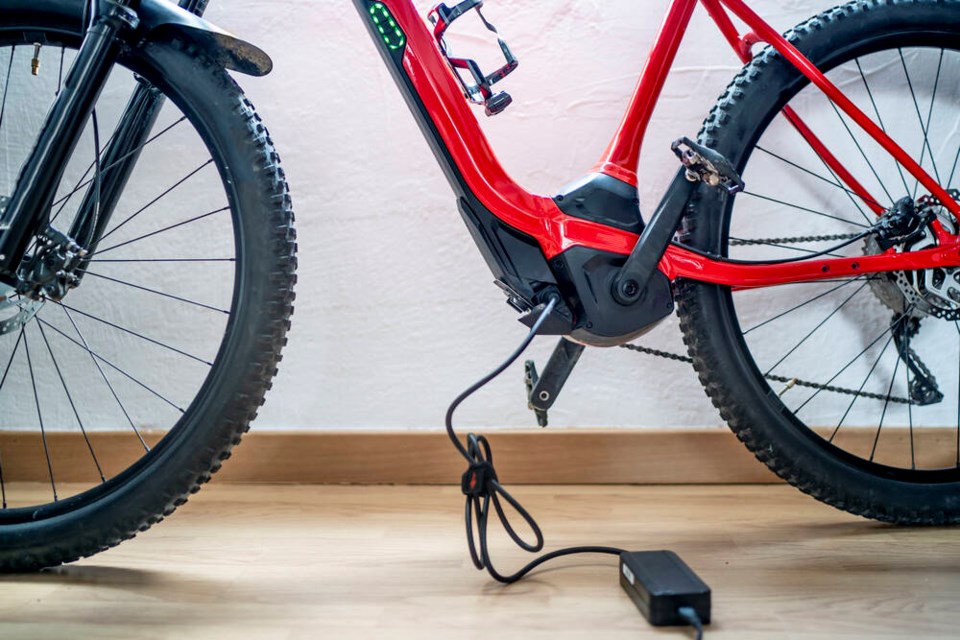Fires caused by malfunctioning e-bike and e-scooter battery charging systems are a growing concern for firefighters throughout North America.
In December 2022, a fire caused by an e-bike battery charger left 10 North Vancouver residents homeless when it destroyed the house where they were renting suites.
Four single-room occupancy hotels operated by non-profit housing groups on Vancouver’s Downtown Eastside were damaged by fires caused by e-bike lithium-ion batteries in just a three-week period in August 2022. In June, a man in a Downtown Eastside SRO was killed when an e-bike battery exploded in his room.
Lithium-ion batteries are used in modern technologies from phones to Teslas. As the batteries get larger and the systems that house and regulate them more complicated, they can also be vulnerable to problems.
Damaged or defective batteries can overheat, catch fire, or explode. According to City of North Vancouver Fire and Rescue, lithium-ion battery fires give off toxic gases and they burn extremely hot.
Why do e-bike batteries catch fire?
There can be several reasons. In some cases, lower quality batteries used in some cheaper e-bikes are poorly made and/or lack the more rigorous safety testing of higher-quality certified battery systems. In the worst scenarios, batteries that aren’t supposed to touch can get knocked out of position and may lean against each other, causing a “thermal cascade.”
Some e-bikes catch fire if they are left plugged in too long. E-bikes should also never be plugged in with an extension cord.
Perhaps more commonly, fire hazards are caused when e-bike battery packs are modified or used with a charger that is not intended for that e-bike. “If a battery pack is broken open to jerry rig a re-charging system, it’s possible to damage it,” said James Wilson of North Vancouver’s Obsession Bikes. “If you use the wrong charger on a bike, you are for sure inviting disaster.”
In the case of e-scooters, an additional problem is that the battery pack is usually located underneath the foot pad, said Wilson, making it especially vulnerable. “If you keep slamming it into the curb, you’ll eventually set it off.”
How can I prevent my e-bike battery from catching fire?
- Most of the well-known e-bike brands bought from reputable dealers are safe bets, said Wilson, but some lower-end products ordered online or bought second-hand may not meet the same battery safety standards. Consider that, whether buying an e-bike new or second-hand. “If the price of the bike is too good to be true, it’s probably to be avoided,” said Wilson. “It’s impossible to build a bicycle for $200, so what are you getting hold of?”
- Look for an e-bike with an Underwriters Laboratory (UL) certification. In 2020, the international safety science organization launched its UL2840 standard for electrical systems for e-bikes, the gold standard safety certification which is recognized but not mandatory in Canada and the United States. “UL is the gold standard,” said Wilson.
- Only charge your e-bike or e-scooter until it’s fully charged.
- Do not leave your e-bike charging overnight and do not leave it charging unsupervised (i.e., when nobody is home). Most bikes will charge within a couple of hours, said Wilson, but if timing is awkward, put the charger on a timer that will automatically shut it off – a system he uses at his own store.
- Don’t charge batteries at temperatures below 0°C (32°F) or above 40°C (105°F).
- Only use the battery, charger, and charging cord that were designed for, and came with, the device, and follow the manufacturer’s instructions.
- Don’t charge an e-bike with a battery system that’s been tampered with or modified. If you’ve lost the charging cord, contact a bike shop or the manufacturer for a replacement. And if you’ve crashed your bike and fear the battery may have been damaged, take it to a reputable shop to have it checked out.
For more information and safety tips for lithium-ion battery charging, check out the City of North Vancouver Fire and Rescue's tip sheet.



